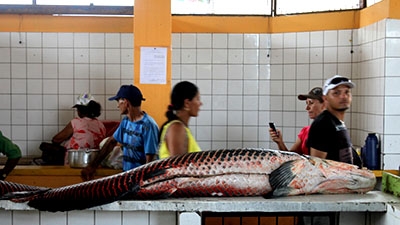An Amazonian legend has it that the pirarucu, one of the world’s largest freshwater species, is an evil indigenous warrior turned fish. This species, which can reach 10 feet and 485 pounds, has a long and narrow body, a rounded tail, and a big mouth – believed to scare ancient fishermen.
In modern days, however, the fish is known to have another superpower: the power to lift at least 1,500 indigenous families from poverty. They carry out a sustainable fishery management initiative in the Alto Solimões region.
While illegal fishing activities start to fall, the population of pirarucus (among other species) is on the rise again, thanks to the effort. “Lakes used to be almost fished-off”, says fisherman Ataíde Gonçalves.
The initiative is part of a greater project that seeks to improve livelihoods in one of the poorest Amazonian regions. It is conducted by state government of Amazonas and the World Bank.
Every breath counts
In this remote region, Pirarucus can be found in lakes connected to the Solimões River and located mostly inside indigenous lands. Project technicians and fishermen unions classified these lakes according to their usage:
• Conservation lakes are used for breeding and cannot be touched;
• At the fishery management lakes, fishermen can work from March to November and have a catch share;
• At the “maintenance” lakes, there isn’t a close season and fishermen are allowed to work year-round.
Environmental agents offer grassroots training on the environmental laws. Once the communities have been trained, fishermen and their families take shifts watching the lakes – and reporting illegal activities via radio. In August, the communities also carry out the fish count.
Every 20 minutes, pirarucus swim up to breathe air, and while doing so, they make a particular noise. Experimented fishermen are able to analyze these signs and precisely estimate the fish population.
The figures are then handed to Ibama, Brazil’s environmental authority – and the catch quota for each season is defined accordingly.

